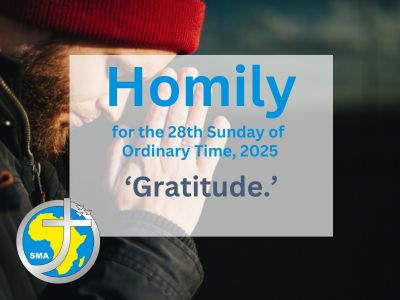Readings: 2 Kings 5:14-17; 2 Timothy 2:8-13; Luke 17:11-19
Theme: Gratitude
By Michael McCabe, SMA
I recall my grandmother telling us as children, when she was trying to get us to wash our hands before sitting down to eat, that ‘cleanliness is next to godliness’. Whatever about the truth of that adage, I am certain that gratitude is godliness. In the words of Isaak Walton, ‘God has two dwellings – one in heaven and the other in a thankful heart’. The great Roman Statesman and Scholar, Cicero, regarded gratitude as ‘not only the greatest of virtues, but the parent of all others’. Two of our readings today feature striking examples of gratitude. In our first reading we hear the story of Naaman, a Syrian Army General, who is cured of leprosy through the intervention of the prophet, Elisha. He goes back to the prophet to express his gratitude and glorify the God of Israel. The gospel recounts Jesus’ cure of ten lepers, one of whom – a Samaritan – returns to give thanks.
Both examples take us by surprise. They manifest the spirit of God present and active in unexpected people and places. Naaman is a Gentile, a citizen of Syria, a nation hostile to, and hated by, the Israelites. Yet, in his time of dire need, and on the advice of an Israelite maidservant, he seeks out a prophet from Israel, Elisha. Then, humbly obeying the prophet’s command, he bathes himself seven times in the river Jordan – a river in Israel – and is cleansed of his leprosy. We are told in a beautiful image that ‘his flesh became clean once more like the flesh of a little child’ (2 Kgs 5: 14). With a heart full of gratitude, he returns to Elisha and gives thanks to the God of Israel in words that manifest a spiritual transformation as well as a physical healing: ‘Now I know that there is no God in all the earth except in Israel’ (2 Kgs 5:15).
The central character in our gospel reading is a Samaritan. He is one of ten lepers healed by Jesus while on his way to Jerusalem to suffer and die. The point of the story is that this despised ‘foreigner’ is the only one who returns to thank Jesus and to praise God for his healing. The other nine seem to take their miraculous healing for-granted. They show no desire to find out more about the one who had healed them. They don’t even have the common courtesy to thank him. They just continue on their way oblivious to the great blessing they have received. The Samaritan, on the other hand, is overcome with gratitude and joy at what Jesus has done for him. He praises God in a loud voice, publicising to all around the wonders of the Lord. He has become an evangelizer. No longer shunned and isolated – as when he was a leper – he now draws close to Jesus and falls on his face at his feet and thanks him (cf. Lk 17:15-16).
This is the second time in Luke’s gospel that a Samaritan is presented to us as a model of godly behaviour. The first time is in the familiar story of The Good Samaritan (Luke 10:25-37). Jesus acknowledges that the healing of the Samaritan leper is more than skin deep. He is healed both in body and in spirit. Hence, Jesus says to him: ‘Stand up and go on your way. Your faith has saved you’ (Lk 17:19). What a great tribute to the faith and godliness of a derided heretic!
Both Naaman and the grateful Samaritan show that genuine gratitude flows from a heart attuned to the presence and action of God’s spirit – faith-filled hearts, appreciative of the gifts they have received from God and others. Sometimes it takes a painful experience to make us truly grateful, as was the case with Naaman and the Samaritan. When things are going well, we can easily take our blessings for-granted. Looking back on my own life, I must admit for many years I took for-granted all I had received from others, especially from my Mum and Dad. Only later, when I had more experience of life, did I come to realise and appreciate the sacrifices they made for me and to be truly grateful. Gratitude is much more than saying thanks, though that is important. It is acting out our awareness of being blessed by the way we live. It is, in the words of the American author, Wilferd A. Peterson, practising the art of thanks-living. I conclude with an abbreviated version of his thoughtful reflection:
The art of thanksgiving is thanks-living.
It is gratitude in action.
It is thanking God for your talents and abilities by accepting them as obligations to be invested for the common good.
It is thanking God for all that others have done for you by doing things for others.
It is thanking God for opportunities by accepting them as a challenge to achievement.
It is thanking God for beauty by helping to make the world more beautiful.
It is thanking God for inspiration by trying to be an inspiration for others.
It is thanking God for health and strength by the care and reverence you show your body.
It is thanking God for each new day by living it to the fullest.
It is thanking God by giving hands, arms, legs, and voice to your thankful spirit.
It is adding to your prayers of thanksgiving, acts of thanks living.’
Listen to an alternative audio Homily by Tom Casey, SMA:

